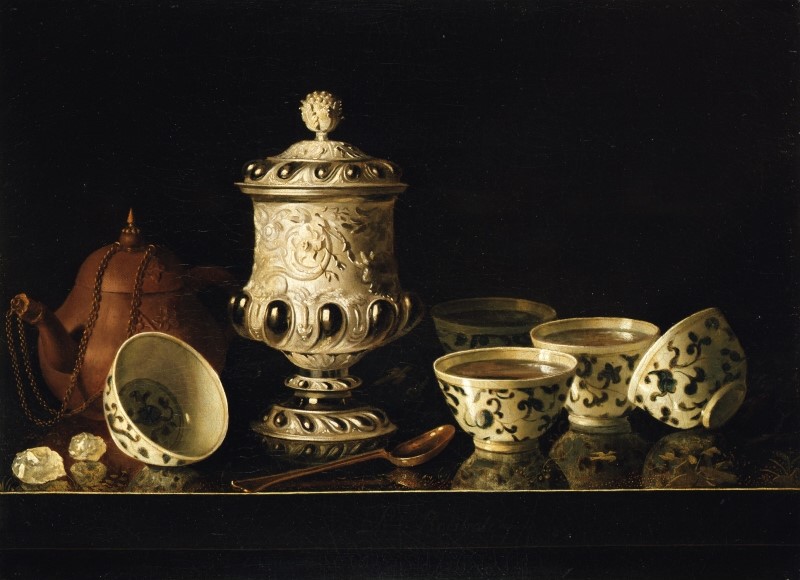Rendering the Surface: Representing Lacquerware in Early Modern European Paintings
Published: 19 May 2021 - Cheng He
The painting reproduced as Figure 1 was created by one of the most highly regarded still life painters of his time: the Flemish Artist Osias Beert the Elder (1580-1624). The scene is filled with a rich array of food and fine utensils: a glistening dish of oysters, crusty bread, exquisite glasses with wine, wooden boxes, a cup of chestnuts and a few handfuls of figs in the left corner. The receptacle for the figs is more difficult to make out. The dark surface suggests a more mysterious material. Would you know how it was made? Would you know what its black and gold surface represented?

Figure 1: Osias Beert the Elder, Still life, first quarter of the 17th century, oil on panel, Museo del Prado, Madrid, 43 x 54 cm.
It is, in fact, a lacquer cup. This means that the surface was varnished with a glue-like material, applied in many layers, eventually providing a visually dazzling surface. From the early sixteenth century, lacquerwares made in Asia were increasingly brought to Europe and highly valued for their quality. For early modern Europeans, this material was exotic and charming, but its technique and material were little-known. How, then, would artists choose to represent this precious and mysterious but desirable material in their paintings?
Colours and Patterns
The lacquerware pieces that artists represented in their paintings largely came as part of the trade in luxury goods between Asia and Europe, and arrived mainly through Portuguese and Dutch maritime trade from the first half of the sixteenth century.[1] These lacquerwares were often done in a mixed style: figures, landscape and patterns that are commonly seen in East Asian art objects were depicted on the surface, sometimes merged with elements of European art.[2] The most popular colour scheme, usually with black chosen for the background and gold for painted patterns, was called nanban style, meaning ‘southern barbarian’ in Japanese. Over the next two centuries, this remained the dominant and typical colour impression of East Asian lacquerware.
Therefore, the visual representation of lacquerware in early modern Europe was not only about lustrous surfaces but also about the ensemble of the visual features of these objects. It is then not surprising that artists could emphasize different aspects. One of the most direct ways of visualising lacquer is to render particular colours rather than a shiny varnish: black and gold (sometimes also with red) are the primary visual clues pointing to the representation of lacquer objects. This is not only one of the most common ways that artists chose to represent Asian lacquerware, but also the way in which art historians today identify the presence of lacquerwares in paintings.
The painting reproduced above is a good example because the object is identified as lacquerware largely due to its black and gold colours. Another crucial clue lies in the patterns on its surface: a flower (probably peony, a motif of auspicious meaning, commonly seen in Chinese art objects) with branches in a swirling pattern is portrayed in gold colour on the surface of the cup, executed in a relatively sketchy manner. It is entirely possible that this sketchy quality is due to the coarse quality of the actual object. But even if artists did simplify the representation of lacquerware in paintings, this did not make such objects less recognizable.

Figure 2: Jan Brueghel the Elder and Hendrik van Baelen, The Winter (detail), 1616, Bayerische Staatsgemäldesammlungen, Munich, 57.1 x 84.6 cm.
Similar examples can be found in a contemporary painting by the Flemish artists Jan Brueghel the Elder (1568-1625) and Hendrick van Baelen (1575-1632) (Figure 2). The combination of black and gold, sometimes with red, and common East Asian decorative motifs became a symbol of the precious liquid applied to the surface of the objects depicted in paintings, even when there was little intention of emphasizing the crucial feature of such material—the reflectivity, transparency of the coating. This more or less suggests that, in the early seventeenth century, the general impression of Asian lacquerware (the collocation of certain colours, objects, and decorative patterns), which paved the way for the definition of lacquer in modern art, had already started to take shape.
Transparency and Lustre
But this was certainly not the only way of painting lacquer. There were different reasons for the selection of objects to depict, which gave rise to individual forms of artistic expression, such as the preference of the person who commissioned the painting, the style favoured by the public, the artist’s own interests or past experiences, and so on. The lustre of lacquer in some cases took centre stage in terms of the artistic expression. Among all the European artists in the early modern period, Pieter van Roestraeten (1630-1700), a Dutch painter active in England during the second half of the seventeenth century, was probably the most representative artist who was prolific in the depiction of the lustrous surfaces of lacquerware.

Figure 3: Pieter van Roestraeten, Still life with Chinese tea cups, 1670s, oil on canvas, Staatliche Museen zu Berlin, Berlin, 35 x 47.5 cm.
Unlike most contemporary painters who only depicted lacquered containers, Roestraeten knew well how to display and make full use of the reflectivity of lacquer by depicting shiny objects on a lacquer table, as we see in the still life that portrays precious commodities (Figure 3). Placed in a dim setting with a dark background, the reflection on the lacquer table can be fully displayed, as if the objects were resting on still water. The silver spoon, the translucent sugar lumps, and lustrous porcelain cups add radiance to the table, which reflects the radiance back to the objects. The reflections merge with the golden chinoiserie decorations, which are not especially emphasised but give way to the reflective surface.
In a biography of contemporary artists written by the British painter Bainbrigg Buckeridge (1668-1733), the author described Roestraeten as ‘…an excellent master in that kind of Painting, viz. in gold and silver plate, gems, shells, musical instruments, &c. to all which gave an unusual lustre in his colouring, and for which his pictures bear a good price.’[3] This short description summarizes the artist’s stylistic feature and, more importantly, points to the popularity of depicting the lustre of objects in paintings. It reveals how lacquerware was consumed in seventeenth-century England. Meanwhile, because depicting the lustre required such outstanding techniques of rendering the light and reflection, it provided a good opportunity for demonstrating an artist’s virtuoso painting skill—another reason for the ‘good price’ of a painting.

Figure 4: Jan Jansz. Treck, Vanitas Still Life, 1648, oil on oak, The National Gallery, London, 90.5 x 78.4 cm.
Luxury and Vanity
This popular and high-level skill of portraying lacquer indicates that the meaning ‘glossy varnish’ of lacquer became prominent in the seventeenth century. It is a meaning that bore a relation to other glossy materials, such as glass, silver, porcelain, etc. Lacquer could even be depicted alone in images to denote this aspect without any chinoiserie decorations. In such cases, lacquer is used to express something beyond luxury consumption or sensual pleasure. One example is a painting by the Dutch artist Jan Jansz. Treck (Figure 4), completed in 1648. This type of still life painting is called ‘vanitas’, which depicts ‘an object or collection of objects symbolizing the brevity of life and the transience of all earthly pleasures and achievements'.[4]
On the table are valuable objects arranged in a seemingly casual but harmonious composition. What the objects all share is a symbolic reference to the inevitability of death and the futility of the material world: an hourglass (passing of time), a skull (inevitability of death), a shell with a straw for blowing bubbles (brevity of life), a luxury textile with gold threads (vanity and wealth), etc.

Figure 5: Jan Jansz. Treck, Vanitas Still Life, 1648, oil on oak, The National Gallery, London, 90.5 x 78.4 cm (detail).
The lacquer box stands in the middle, covered by a piece of silk pressed down by the skull (Figure 5). Although the box is in plain black except for the golden keyhole and the key inserted, there is reflection of the silk on the upper side of the box, partly covered by the shadow of the skull. It is gently depicted at the left corner but can still be easily found, providing a visual evidence for the material applied to the surface of the box. The lustrous feature endows lacquer (here as varnish) with the function of a mirror, but the relationship between the lacquered surface, the silk and skull is reciprocal: lacquer identifies itself by reflecting the earthly pleasures (i.e. the silk) and the impermanence of life (i.e. the skull), without which the lustrous surface of the lacquer would not be revealed.
Thus, to put the objects on the lacquer box was probably not an arbitrary choice made by Treck. Unlike the lacquered surfaces in Roestraeten’s paintings which were done with extraordinary techniques of representing reflections and focusing on the exquisite texture of luxury objects, the lacquer box in Treck’s work is perhaps less visually dazzling but all the more significant, as it magnifies the idea of ‘glossy varnish’ that seamlessly integrates the material into the vanitas genre with its moralistic message.
From the works presented here, we can see that a liquid substance like lacquer could be expressed on canvas with different emphases (such as decorative detail, colour scheme, reflectivity) when appearing on different objects. Moreover, while the exotic qualities of lacquer are often highlighted, lacquer was at the same time assimilated into different genres and contexts in paintings, which conversely enriched the cultural meanings of lacquer.
Cheng He is a second-year PhD student in the History Department at Warwick. Her doctoral research centres on how the concept of ‘lacquer’ took shape in early modern England, by looking at the materiality and ways of use of the material. She tries to demonstrate that ‘lacquer’ could be used as medicine, pigment and sealing wax apart from being varnish, which was related to its particular material properties that people chose to utilise. She is interested in art materials, visual representation of materials and the making of knowledge.
[1] Oliver Impey and Christiaan Jörg, Japanese Export Lacquer: 1580-1850 (Amsterdam: Hotei, 2005)
[2] See Daniëlle Kisluk-Grosheide, 'Lacquer and Japanning in Seventeenth-Century Flemish and Dutch Paintings', Magazine Antiques 162: 4 (2002), pp. 153-55.
[3] Bainbrigg Buckeridge, ‘Essay towards an English School of Painting’, in Roger de Piles, Antoine Coypel, and Bainbrigg Buckeridge, The Art of Painting, and the Lives of the Painters : Containing a Compleat Treatise of Painting, Designing, and the Use of Prints : with Reflections on the Works of the Most Celebrated Painters, and of the Several Schools of Europe, as Well Ancient as Modern: Being The Newest, And Most Perfect Work of the Kind Extant (London: Printed for J. Nutt near Stationers-Hall, 1706), pp. 459-460.
[4] Ian Chilvers (ed.), 'vanitas', in The Oxford Dictionary of Art and Artists, Fifth Edition (Oxford: Oxford University Press Published Online, 2015, first published 1990), consulted 31 March, 2021.

